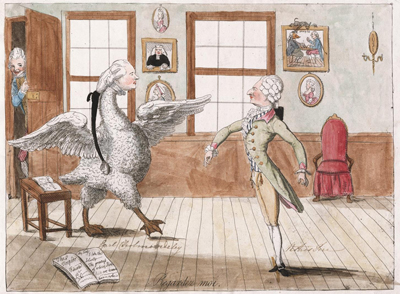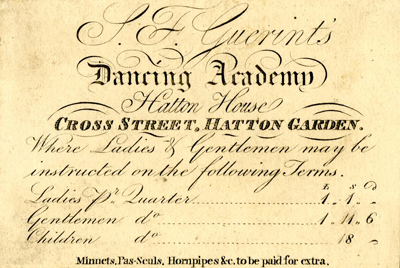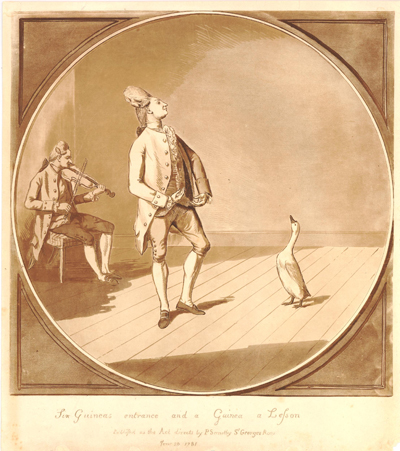Regardez Moi
This truly odd-looking print shows the famous French dancer, Gaetan Vestris, with admirable poise instructing a massive overstuffed goose representing Earl Cholmondeley to "regardez moi" (look at me) in order to learn how to hold himself in preparation for a dance. A servant in the background (a viewer surrogate) looks on with undisguised amusement.

© Lewis Walpole Library, Yale University
Since Vestris and his family were still dancing at various theaters in London, Gillray would have had the opportunity to see him, his wife, and his son and to capture a likeness of Vestris Senior (Gaetan). But, in this instance, Gillray is more likely to have modelled his likeness on the recent 1781 print portrait by Johann Müller.
As the British Museum commentary points out, the big goose, Earl Cholmondeley, can be identified by the papers behind him on a stool and the open book in the foreground. Both allude to the highly suggestive poem The Torpedo, A Poem to the Electrical Eel dedicated to Lord Cholmondeley because of his superior sexual endowments and his unremitting use of them.*
Prints satirizing the pretentions (and foolishness) of young men spending money learning to dance go back at least as far as Plate 2 of Hogarth's Rake's Progress (1735) where a simpering and effeminate French dancing master occupies a central place among the other "masters" of fencing, hunting, fighting, and music—all vying for a piece of Tom Rakewell's attention and inheritance.
The theme was treated more specifically in John Collett's Grown Gentlemen Taught to Dance (1768) where the principal dancing master is also effeminate with an elaborately ornamenented jacket and curl papers in his hair. He points at his feet as if to show the young man—awkward as well as stupid—how he should be moving. An advertisement on the back wall indicates what he is paying for this.
Grown Gentlemen taught to dance & qualify'd to appear in the most brilliant Assemblies at the easy Expence of £1.11s.6d.
This may have been the standard rate for dance instruction. A Trade Card from the S.F. Guerint Dancing Academy (1780), for instance, shows similar pricing.

© Trustees of the British Museum
But if we can trust Paul Sandy, this was not what the Vestris family charged. Sandby's Six Guineas Entrance and a Guinea a Lesson shows Vestris instructing a realistically sized goose, as if to say, anyone paying those kinds of prices is a silly goose.

Six Guineas Entrance and a Guinea a Lesson
June 20, 1781
© Trustees of the British Museum
But the numerous background details in the Collett print all focus, in one way or another, on its satire of gentlemen dancing. That's not true of Regardez Moi. There the satire is more personal, and focused, in this case, on Cholmonedeley. On the back wall of the print, there are two sets of pictures. On the right is a picture of Charles James Fox and Cholmondeley playing at dice. Cholmondeley has just lost and exclaims "A Nick by God," which I take to mean an accusation of theft or cheating. Since a portrait of a buxom young female is literally attached to the painting of Fox and Cholmondeley, I suspect the reward of the dice roll may have included the favors of the lady.
On the other side of the room, a portrait of a cleric, who seems to be leaning out from the picture frame as if it were a window, is bracketed at top and bottom by two pictures, one of a young lady and the other of an old one. The old one is looking at directly at Cholmondeley. Is the cleric delivering a message from the old and tired-looking Lady Cholmondeley that her errant son should stop dancing and start marrying? If so, the already 32 year old goose ignored both of them. He did not marry for another 10 years.
* Gillray later alluded to Cholmondeley's reputation in this area in Corporeal Stamina (1801) and Dilettanti-Theatricals, or a Peep at the Green Room (1803) where the Earl appears on the far left as an enormous Cupid gripping a strategically placed large and pointed spear.
Sources and Reading
- Commentary from the British Museum on Regardez Moi.
- "Gaétan Vestris," Wikipedia
- "George Cholmondeley, 1st Marquess of Cholmondeley," Wikipedia
- "Charles James Fox," Wikipedia
- The Torpedo, A Poem to the Electrical Eel
Comments & Corrections
NOTE: Comments and/or corrections are always appreciated. To make that easier, I have included a form below that you can use. I promise never to share any of the info provided without your express permission.